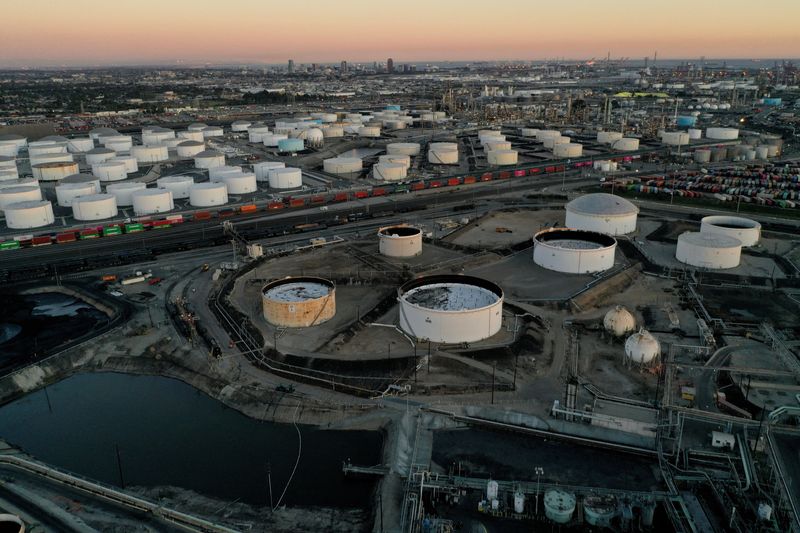Explainer-U.S. gasoline prices are falling again – here’s why
2022.10.19 13:47
[ad_1]

© Reuters. FILE PHOTO: Storage tanks for crude oil, gasoline, diesel, and other refined petroleum products are seen at the Kinder Morgan Terminal, viewed from the Phillips 66 Company’s Los Angeles Refinery in Carson, California, U.S., March 11, 2022. Picture taken M
By Laura Sanicola
(Reuters) -U.S. gasoline prices rose earlier this month but are falling again after West Coast refinery outages subsided and seasonal demand fell.
Prices dropped after a weeks-long rebound after the Organization of the Petroleum Exporting Countries and its allies announced plans to reduce the OPEC+ production target by 2 million barrels a day.
President Joe Biden plans to sell the last portion of a release of 180 million barrels of from U.S. strategic petroleum reserves by the end of December. Biden’s Democrats hope the move will help the party hold thin majorities in both houses of Congress in November’s midterm elections.
Not all prices are falling. U.S. diesel prices have risen in the past two weeks due to high global demand, low inventory levels, and low output in Europe due to refinery strikes in France.
WHERE ARE FUEL PRICES NOW?
The national average is at $3.85 a gallon, up 18 cents from its mid-September lows of $3.67 a gallon, but down from highs reached two weeks ago.
The price of diesel is up 33 cents in the past month, according to data from the U.S. Energy Information Administration, now at $5.32 per gallon.
The United States uses about 9 million barrels of gasoline per day, and about 3 million barrels of diesel, according to federal data.
U.S. oil refineries are running hard to replenish low inventories even has cold weather sets in, which usually corresponds with a drop in demand for fuel. The four-week moving average of gasoline demand is 2.4% lower than this time last year, while refinery utilization is 5% higher.
U.S. gasoline prices rose earlier this year, peaking in June, following western sanctions on Russian energy products and lower global refinery capacity after pandemic-related closures.
WHAT WAS AFFECTING PRICES?
Last month, U.S. gasoline prices rose largely due to regional refinery outages in the west coast and the Midwest. In California, costs are up more than $1 per gallon in the last month whereas in Texas, prices remain lower than a month ago.
Refinery maintenance often occurs in the fall when demand drops after summer driving season. This fall, however, some refineries had to shut units without warning due to infrastructure problems.
Three refineries in Washington state and California had planned maintenance while another had an unplanned outage in September, according to Refinitiv data and refining sources. In the Midwest, BP-Cenovus’ Toledo refinery is still offline after a fatal explosion shut the plant late last month.
In October, several French refineries shut as workers went on strike to combat the higher cost of living, which sent global distillate inventories lower and increased U.S. distillate exports.
U.S. oil refiners were using 89.5% of capacity as of last week, still seasonally high. Overall U.S. refining capacity has declined since the coronavirus pandemic crushed demand in early 2020.
Gasoline produced to meet California’s environmental rules has fallen nearly $2 gallon in Los Angeles and San Francisco wholesale markets in the past month because of increasing supply, traders said.
WHAT OTHER FACTORS ARE AFFECTING FUEL PRICES?
Tight refining supply has kept the gap wide between wholesale gasoline futures and retail prices, currently at about $1.25 a gallon, far exceeding the average of 88 cents over the past five years.
U.S. retail gasoline demand was sluggish throughout the summer, but has improved in the last month, according to federal data. That has kept a lid on inventories, with U.S. stocks of gasoline sitting near an eight-year low. Additional refining upsets could squeeze that inventory more, boosting prices.
[ad_2]
Source link








